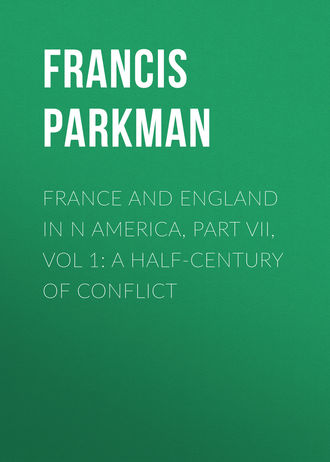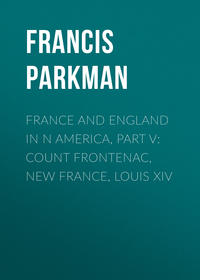 полная версия
полная версияFrance and England in N America, Part VII, Vol 1: A Half-Century of Conflict
Such being the relations of the commandant and the Father Superior, it is not surprising to find the one complaining that he cannot get absolved from his sins, and the other painting the morals and manners of Michilimackinac in the blackest colors.
I have spoken elsewhere of the two opposing policies that divided Canada,—the policies of concentration and of expansion, on the one hand leaving the west to the keeping of the Jesuits, and confining the population to the borders of the St. Lawrence; on the other, the occupation of the interior of the continent by posts of war and trade.21 Through the force of events the latter view had prevailed; yet while the military chiefs of Canada could not but favor it, the Jesuits were unwilling to accept it, and various interests in the colony still opposed it openly or secretly. Frontenac had been its strongest champion, and Cadillac followed in his steps. It seemed to him that the time had come for securing the west for France.
The strait—détroit—which connects Lake Huron with Lake Erie was the most important of all the western passes. It was the key of the three upper lakes, with the vast countries watered by their tributaries, and it gave Canada her readiest access to the valley of the Mississippi. If the French held it, the English would be shut out from the northwest; if, as seemed likely, the English should seize it, the Canadian fur-trade would be ruined.22 The possession of it by the French would be a constant curb and menace to the Five Nations, as well as a barrier between those still formidable tribes and the western Indians, allies of Canada; and when the intended French establishment at the mouth of the Mississippi should be made, Detroit would be an indispensable link of communication between Canada and Louisiana.
Denonville had recognized the importance of the position, and it was by his orders that Greysolon Du Lhut, in 1686, had occupied it for a time, and built a picket fort near the site of Fort Gratiot.23
It would be idle to imagine that the motives of Cadillac were wholly patriotic. Fur-trading interests were deeply involved in his plans, and bitter opposition was certain. The fur-trade, in its nature, was a constant breeder of discord. The people of Montreal would have the tribes come down every summer from the west and northwest and hold a fair under the palisades of their town. It is said that more than four hundred French families lived wholly or in part by this home trade, and therefore regarded with deep jealousy the establishment of interior posts, which would forestall it. Again, every new western post would draw away trade from those already established, and every trading license granted to a company or an individual would rouse the animosity of those who had been licensed before. The prosperity of Detroit would be the ruin of Michilimackinac, and those whose interests centred at the latter post angrily opposed the scheme of Cadillac.
He laid his plans before Count de Maurepas by a characteristic memorial, apparently written in 1699. In this he proposed to gather all the tribes of the lakes at Detroit, civilize them and teach them French, "insomuch that from pagans they would become children of the Church, and therefore good subjects of the King." They will form, he continues, a considerable settlement, "strong enough to bring the English and the Iroquois to reason, or, with help from Montreal, to destroy both of them." Detroit, he adds, should be the seat of trade, which should not be permitted in the countries beyond it. By this regulation the intolerable glut of beaver-skins, which spoils the market, may be prevented. This proposed restriction of the beaver-trade to Detroit was enough in itself to raise a tempest against the whole scheme. "Cadillac well knows that he has enemies," pursues the memorial, "but he keeps on his way without turning or stopping for the noise of the puppies who bark after him."24
Among the essential features of his plan was a well-garrisoned fort, and a church, served not by Jesuits alone, but also by Récollet friars and priests of the Missions Étrangères. The idea of this ecclesiastical partnership was odious to the Jesuits, who felt that the west was their proper field, and that only they had a right there. Another part of Cadillac's proposal pleased them no better. This was his plan of civilizing the Indians and teaching them to speak French; for it was the reproach of the Jesuit missions that they left the savage a savage still, and asked little of him but the practice of certain rites and the passive acceptance of dogmas to him incomprehensible.
"It is essential," says the memorial, "that in this matter of teaching the Indians our language the missionaries should act in good faith, and that his Majesty should have the goodness to impose his strictest orders upon them; for which there are several good reasons. The first and most stringent is that when members of religious orders or other ecclesiastics undertake anything, they never let it go. The second is that by not teaching French to the Indians they make themselves necessary [as interpreters] to the King and the governor. The third is that if all Indians spoke French, all kinds of ecclesiastics would be able to instruct them. This might cause them [the Jesuits] to lose some of the presents they get; for though these Reverend Fathers come here only for the glory of God, yet the one thing does not prevent the other,"—meaning that God and Mammon may be served at once. "Nobody can deny that the priests own three quarters of Canada. From St. Paul's Bay to Quebec, there is nothing but the seigniory of Beauport that belongs to a private person. All the rest, which is the best part, belongs to the Jesuits or other ecclesiastics. The Upper Town of Quebec is composed of six or seven superb palaces belonging to Hospital Nuns, Ursulines, Jesuits, Récollets, Seminary priests, and the bishop. There may be some forty private houses, and even these pay rent to the ecclesiastics, which shows that the one thing does not prevent the other." From this it will be seen that, in the words of one of his enemies, Cadillac "was not quite in the odor of sanctity."
"One may as well knock one's head against a wall," concludes the memorial, "as hope to convert the Indians in any other way [than that of civilizing them]; for thus far all the fruits of the missions consist in the baptism of infants who die before reaching the age of reason."25 This was not literally true, though the results of the Jesuit missions in the west had been meagre and transient to a surprising degree.
Cadillac's plan of a settlement at Detroit was not at first received with favor by Callières, the governor; while the intendant Champigny, a fast friend of the Jesuits, strongly opposed it. By their order the chief inhabitants of Quebec met at the Château St. Louis,—Callières, Champigny, and Cadillac himself being present. There was a heated debate on the beaver-trade, after which the intendant commanded silence, explained the projects of Cadillac, and proceeded to oppose them. His first point was that the natives should not be taught French, because the Indian girls brought up at the Ursuline Convent led looser lives than the young squaws who had received no instruction, while it was much the same with the boys brought up at the Seminary.
"M. de Champigny," returned the sarcastic Cadillac, "does great honor to the Ursulines and the Seminary. It is true that some Indian women who have learned our language have lived viciously; but that is because their teachers were too stiff with them, and tried to make them nuns."26
Champigny's position, as stated by his adversary, was that "all intimacy of the Indians with the French is dangerous and corrupting to their morals," and that their only safety lies in keeping them at a distance from the settlements. This was the view of the Jesuits, and there is much to be said in its favor; but it remains not the less true that conversion must go hand in hand with civilization, or it is a failure and a fraud.
Cadillac was not satisfied with the results of the meeting at the Château St. Louis, and he wrote to the minister: "You can never hope that this business will succeed if it is discussed here on the spot. Canada is a country of cabals and intrigues, and it is impossible to reconcile so many different interests."27 He sailed for France, apparently in the autumn of 1699, to urge his scheme at court. Here he had an interview with the colonial minister, Ponchartrain, to whom he represented the military and political expediency of his proposed establishment;28 and in a letter which seems to be addressed to La Touche, chief clerk in the Department of Marine and Colonies, he promised that the execution of his plan would insure the safety of Canada and the ruin of the British colonies.29 He asked for fifty soldiers and fifty Canadians to begin the work, to be followed in the next year by twenty or thirty families and by two hundred picked men of various trades, sent out at the King's charge, along with priests of several communities, and nuns to attend the sick and teach the Indian girls. "I cannot tell you," continues Cadillac, "the efforts my enemies have made to deprive me of the honor of executing my project; but so soon as M. de Ponchartrain decides in its favor, the whole country will applaud it."
Ponchartrain accepted the plan, and Cadillac returned to Canada commissioned to execute it. Early in June, 1701, he left La Chine with a hundred men in twenty-five canoes loaded with provisions, goods, munitions, and tools. He was accompanied by Alphonse de Tonty, brother of Henri de Tonty, the companion of La Salle, and by two half-pay lieutenants, Dugué and Chacornacle, together with a Jesuit and a Récollet.30 Following the difficult route of the Ottawa and Lake Huron, they reached their destination on the twenty-fourth of July, and built a picket fort sixty yards square, which by order of the governor they named Fort Ponchartrain.31 It stood near the west bank of the strait, about forty paces from the water.32 Thus was planted the germ of the city of Detroit.
Cadillac sent back Chacornacle with the report of what he had done, and a description of the country written in a strain of swelling and gushing rhetoric in singular contrast with his usual sarcastic utterances. "None but enemies of the truth," his letter concludes, "are enemies of this establishment, so necessary to the glory of the King, the progress of religion, and the destruction of the throne of Baal."33
What he had, perhaps, still more at heart was making money out of it by the fur-trade. By command of the King a radical change had lately been made in this chief commerce of Canada, and the entire control of it had been placed in the hands of a company in which all Canadians might take shares. But as the risks were great and the conditions ill-defined, the number of subscribers was not much above one hundred and fifty; and the rest of the colony found themselves shut out from the trade,—to the ruin of some, and the injury of all.34
All trade in furs was restricted to Detroit and Fort Frontenac, both of which were granted to the company, subject to be resumed by the King at his pleasure.35 The company was to repay the eighty thousand francs which the expedition to Detroit had cost; and to this were added various other burdens. The King, however, was to maintain the garrison.
All the affairs of the company were placed in the hands of seven directors, who began immediately to complain that their burdens were too heavy, and to beg for more privileges; while an outcry against the privileges already granted rose from those who had not taken shares in the enterprise. Both in the company and out of it there was nothing but discontent. None were worse pleased than the two Jesuits Carheil and Marest, who saw their flocks at Michilimackinac, both Hurons and Ottawas, lured away to a new home at Detroit. Cadillac took a peculiar satisfaction in depriving Carheil of his converts, and in 1703 we find him writing to the minister Ponchartrain, that only twenty-five Hurons are left at Michilimackinac; and "I hope," he adds, "that in the autumn I shall pluck this last feather from his wing; and I am convinced that this obstinate priest will die in his parish without one parishioner to bury him."36
If the Indians came to Detroit, the French would not come. Cadillac had asked for five or six families as the modest beginning of a settlement; but not one had appeared. The Indians, too, were angry because the company asked too much for its goods; while the company complained that a forbidden trade, fatal to its interests, went on through all the region of the upper lakes. It was easy to ordain a monopoly, but impossible to enforce it. The prospects of the new establishment were deplorable; and Cadillac lost no time in presenting his views of the situation to the court. "Detroit is good, or it is bad," he writes to Ponchartrain. "If it is good, it ought to be sustained, without allowing the people of Canada to deliberate any more about it. If it is bad, the court ought to make up its mind concerning it as soon as may be. I have said what I think. I have explained the situation. You have felt the need of Detroit, and its utility for the glory of God, the progress of religion, and the good of the colony. Nothing is left me to do but to imitate the governor of the Holy City,—take water, and wash my hands of it." His aim now appears. He says that if Detroit were made a separate government, and he were put at the head of it, its prospects would improve. "You may well believe that the company cares for nothing but to make a profit out of it. It only wants to have a storehouse and clerks; no officers, no troops, no inhabitants. Take this business in hand, Monseigneur, and I promise that in two years your Detroit shall be established of itself." He then informs the minister that as the company complain of losing money, he has told them that if they will make over their rights to him, he will pay them back all their past outlays. "I promise you," he informs Ponchartrain, "that if they accept my proposal and you approve it, I will make our Detroit flourish. Judge if it is agreeable to me to have to answer for my actions to five or six merchants [the directors of the company], who not long ago were blacking their masters' boots." He is scarcely more reserved as to the Jesuits. "I do what I can to make them my friends, but, impiety apart, one had better sin against God than against them; for in that case one gets one's pardon, whereas in the other the offence is never forgiven in this world, and perhaps never would be in the other, if their credit were as great there as it is here."37
The letters of Cadillac to the court are unique. No governor of New France, not even the audacious Frontenac, ever wrote to a minister of Louis XIV. with such off-hand freedom of language as this singular personage,—a mere captain in the colony troops; and to a more stable and balanced character it would have been impossible.
Cadillac's proposal was accepted. The company was required to abandon Detroit to him on his paying them the expenses they had incurred. Their monopoly was transferred to him; but as far as concerned beaver-skins, his trade was limited to twenty thousand francs a year. The governor was ordered to give him as many soldiers as he might want, permit as many persons to settle at Detroit as might choose to do so, and provide missionaries.38 The minister exhorted him to quarrel no more with the Jesuits, or anybody else, to banish blasphemy and bad morals from the post, and not to offend the Five Nations.
The promised era of prosperity did not come. Detroit lingered on in a weak and troubled infancy, disturbed, as we shall see, by startling incidents. Its occupation by the French produced a noteworthy result. The Five Nations, filled with jealousy and alarm, appealed to the King of England for protection, and, the better to insure it, conveyed the whole country from Lake Ontario northward to Lake Superior, and westward as far as Chicago, "unto our souveraigne Lord King William the Third" and his heirs and successors forever. This territory is described in the deed as being about eight hundred miles long and four hundred wide, and was claimed by the Five Nations as theirs by right of conquest.39 It of course included Detroit itself. The conveyance was drawn by the English authorities at Albany in a form to suit their purposes, and included terms of subjection and sovereignty which the signers could understand but imperfectly, if at all. The Five Nations gave away their land to no purpose. The French remained in undisturbed possession of Detroit. The English made no attempt to enforce their title, but they put the deed on file, and used it long after as the base of their claim to the region of the Lakes.
CHAPTER III
1703-1713QUEEN ANNE'S WARThe Forest of Maine.—A Treacherous Peace.—A Frontier Village.—Wells and its People.—Attack upon it.—Border Ravages.—Beaubassin's War-party.—The "Woful Decade."—A Wedding Feast.—A Captive Bridegroom.
For untold ages Maine had been one unbroken forest, and it was so still. Only along the rocky seaboard or on the lower waters of one or two great rivers a few rough settlements had gnawed slight indentations into this wilderness of woods; and a little farther inland some dismal clearing around a blockhouse or stockade let in the sunlight to a soil that had lain in shadow time out of mind. This waste of savage vegetation survives, in some part, to this day, with the same prodigality of vital force, the same struggle for existence and mutual havoc that mark all organized beings, from men to mushrooms. Young seedlings in millions spring every summer from the black mould, rich with the decay of those that had preceded them, crowding, choking, and killing one another, perishing by their very abundance,—all but a scattered few, stronger than the rest, or more fortunate in position, which survive by blighting those about them. They in turn, as they grow, interlock their boughs, and repeat in a season or two the same process of mutual suffocation. The forest is full of lean saplings dead or dying with vainly stretching towards the light. Not one infant tree in a thousand lives to maturity; yet these survivors form an innumerable host, pressed together in struggling confusion, squeezed out of symmetry and robbed of normal development, as men are said to be in the level sameness of democratic society. Seen from above, their mingled tops spread in a sea of verdure basking in light; seen from below, all is shadow, through which spots of timid sunshine steal down among legions of lank, mossy trunks, toadstools and rank ferns, protruding roots, matted bushes, and rotting carcasses of fallen trees. A generation ago one might find here and there the rugged trunk of some great pine lifting its verdant spire above the undistinguished myriads of the forest. The woods of Maine had their aristocracy; but the axe of the woodman has laid them low, and these lords of the wilderness are seen no more.
The life and light of this grim solitude were in its countless streams and lakes, from little brooks stealing clear and cold under the alders, full of the small fry of trout, to the mighty arteries of the Penobscot and the Kennebec; from the great reservoir of Moosehead to a thousand nameless ponds shining in the hollow places of the forest.
It had and still has its beast of prey,—wolves, savage, cowardly, and mean; bears, gentle and mild compared to their grisly relatives of the Far West, vegetarians when they can do no better, and not without something grotesque and quaint in manners and behavior; sometimes, though rarely, the strong and sullen wolverine; frequently the lynx; and now and then the fierce and agile cougar.
The human denizens of this wilderness were no less fierce, and far more dangerous. These were the various tribes and sub-tribes of the Abenakis, whose villages were on the Saco, the Kennebec, the Penobscot, and the other great watercourses. Most of them had been converted by the Jesuits, and, as we have seen already, some had been persuaded to remove to Canada, like the converted Iroquois of Caughnawaga.40 The rest remained in their native haunts, where, under the direction of their missionaries, they could be used to keep the English settlements in check.
We know how busily they plied their tomahawks in William and Mary's War, and what havoc they made among the scattered settlements of the border.41 Another war with France was declared on the fourth of May, 1702, on which the Abenakis again assumed a threatening attitude. In June of the next year Dudley, governor of Massachusetts, called the chiefs of the various bands to a council at Casco. Here presently appeared the Norridgewocks from the Kennebec, the Penobscots and Androscoggins from the rivers that bear their names, the Penacooks from the Merrimac, and the Pequawkets from the Saco, all well armed, and daubed with ceremonial paint. The principal among them, gathered under a large tent, were addressed by Dudley in a conciliatory speech. Their orator replied that they wanted nothing but peace, and that their thoughts were as far from war as the sun was from the earth,—words which they duly confirmed by a belt of wampum.42 Presents were distributed among them and received with apparent satisfaction, while two of their principal chiefs, known as Captain Samuel and Captain Bomazeen, declared that several French missionaries had lately come among them to excite them against the English, but that they were "firm as mountains," and would remain so "as long as the sun and moon endured." They ended the meeting with dancing, singing, and whoops of joy, followed by a volley of musketry, answered by another from the English. It was discovered, however, that the Indians had loaded their guns with ball, intending, as the English believed, to murder Dudley and his attendants if they could have done so without danger to their chiefs, whom the governor had prudently kept about him. It was afterwards found, if we may believe a highly respectable member of the party, that two hundred French and Indians were on their way, "resolved to seize the governor, council, and gentlemen, and then to sacrifice the inhabitants at pleasure;" but when they arrived, the English officials had been gone three days.43
The French governor, Vaudreuil, says that about this time some of the Abenakis were killed or maltreated by Englishmen. It may have been so: desperadoes, drunk or sober, were not rare along the frontier; but Vaudreuil gives no particulars, and the only English outrage that appears on record at the time was the act of a gang of vagabonds who plundered the house of the younger Saint-Castin, where the town of Castine now stands. He was Abenaki by his mother; but he was absent when the attack took place, and the marauders seem to have shed no blood. Nevertheless, within six weeks after the Treaty of Casco, every unprotected farmhouse in Maine was in a blaze.
The settlements of Maine, confined to the southwestern corner of what is now the State of Maine, extended along the coast in a feeble and broken line from Kittery to Casco. Ten years of murderous warfare had almost ruined them. East of the village of Wells little was left except one or two forts and the so-called "garrisons," which were private houses pierced with loopholes and having an upper story projecting over the lower, so that the defenders could fire down on assailants battering the door or piling fagots against the walls. A few were fenced with palisades, as was the case with the house of Joseph Storer at the east end of Wells, where an overwhelming force of French and Indians had been gallantly repulsed in the summer of 1692.44 These fortified houses were, however, very rarely attacked, except by surprise and treachery. In case of alarm such of the inhabitants as found time took refuge in them with their families, and left their dwellings to the flames; for the first thought of the settler was to put his women and children beyond reach of the scalping-knife. There were several of these asylums in different parts of Wells; and without them the place must have been abandoned. In the little settlement of York, farther westward, there were five of them, which had saved a part of the inhabitants when the rest were surprised and massacred.
Wells was a long, straggling settlement, consisting at the beginning of William and Mary's War of about eighty houses and log-cabins,45 strung at intervals along the north side of the rough track, known as the King's Road, which ran parallel to the sea. Behind the houses were rude, half-cleared pastures, and behind these again, the primeval forest. The cultivated land was on the south side of the road; in front of the houses, and beyond it, spread great salt-marshes, bordering the sea and haunted by innumerable game-birds.







